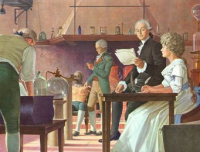








Humphry Davy first noted the anesthetic effects of nitrous oxide- a colorless,almost odorless gas- while experimenting at the pneumatic institute in bristol,England .Davy realized that nitrous oxide both made him want to laugh and relieved his toothache.
In 1800 he published a book stating that the gas might "be used with advantage during surgical operations."After Davy's observations,nitrous oxide became popular at laughing parties and fairfround shows ,but it was not ued in surgery for another forty years.
At one fair in the united states,Horace wells, a connecticut dentist,observed a man who gashed his leg while under the influence of nitrous oxide.He seemed to be pain-free,and wells immediately had one of his own teeth removed while breathing in the gas.In january 1845,wells demonstrated the use of nitrous oxide in a dental extraction at the harvard medical school in Massachusetts. unfortunately,insufficient gas was applied and the patient cried out in pain.The public humilation resulted in Wells's loss of reputation as a dentist and tragically to his suicide three years later.The next yaear dentist William Morton successfully used the gas while a surgeon removed a tumor from a man's neck and use of nitrous oxide in surgery then quickly caught on in london and paris.
Today,nitrous oxide continues to be used during childbirth and in dentistry to allay anxiety and offer some degree of analgesia.As an anesthetic it has survived chloroform,which proved too toxic,and ether,which posted too high a risk as an explosive.